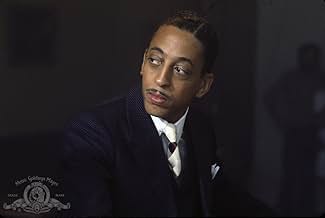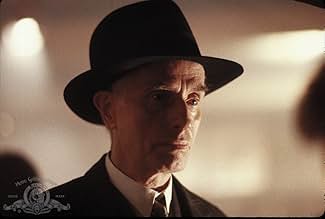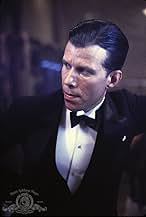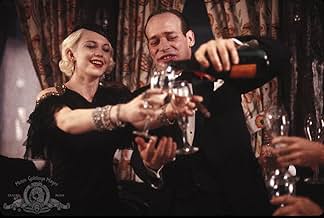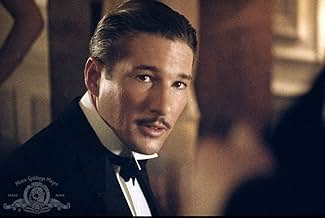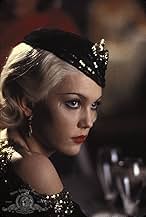AVALIAÇÃO DA IMDb
6,5/10
20 mil
SUA AVALIAÇÃO
Conheça os músicos de jazz, dançarinos, proprietários e convidados do Cotton Club em Harlem de 1928 a 1930.Conheça os músicos de jazz, dançarinos, proprietários e convidados do Cotton Club em Harlem de 1928 a 1930.Conheça os músicos de jazz, dançarinos, proprietários e convidados do Cotton Club em Harlem de 1928 a 1930.
- Indicado a 2 Oscars
- 1 vitória e 8 indicações no total
Laurence Fishburne
- Bumpy Rhodes
- (as Larry Fishburne)
John P. Ryan
- Joe Flynn
- (as John Ryan)
Enredo
Você sabia?
- CuriosidadesWhen Francis Ford Coppola called up Bob Hoskins to offer him a part, the actor didn't believe it was really him. Coppola introduced himself, to which Hoskins replied, "Yeah, and this is Henry the fucking Eighth", and hung up.
- Erros de gravaçãoDuring the montage song Ill Wind there is a shot of coins and bills being poured out. The dimes in the shot are Roosevelt dimes, not produced until 1946.
- Cenas durante ou pós-créditosIn the original version, the opening credits were intercut with dancers performing "The Mooche." In the 2019 revision, the dancing is eliminated and the credits roll straight through, but have been joined with straight cuts rather than dissolves. Additionally, Coppola has changed his billing from "Francis Coppola" to "Francis Ford Coppola." Finally, restoration credits have been added after the end titles.
- Versões alternativasIn 2019, Lionsgate released a director's cut running 139 minutes, titled "The Cotton Club Encore". This version gave more space to the Williams brothers and Lila Rose, restoring three full musical numbers and extending others, and trimming scenes with impersonations of 1920s celebrities.
- ConexõesEdited into Lonette McKee: Ill Wind (1984)
- Trilhas sonorasHow Come You Love Me Like You Do?
Written by Gene Austin and Roy Bergere
Avaliação em destaque
The Cotton Club is a dazzling, complex film that attempts so much it would be almost impossible for nearly any director to pull it off. But Francis Ford Coppola is not any director, so The Cotton Club is not just any movie. Rather, it succeeds at practically all levels and is certainly a film worth coming back to again and again.
Set in Harlem in the late 1920s, we are introduced to a group of Jazz Age-products, people who see themselves exactly as they are but all hope to go somewhere better. Two story lines occupy the plot; we get a good-looking young musician Dixie Dwyer (Richard Gere) who gets involved in the mob after falling for one of the gangster's girlfriends (Diane Lane) and we get the story of a very talented black dancer (Gregory Hines) trying to prove his love to a half-black and half-white chorus girl who seems to struggle with her place in this more or less racist society. Almost every night, everyone gathers at The Cotton Club, one of the most famous clubs in the city and the blacks entertain while the whites drink and watch. But Coppola gives us a view from all angles so it doesn't feel as if we are missing anything important.
One of the biggest achievements of this film is its staging of the dance sequences, which are to say the least quite exquisite. Filled with colorful costumes and some mind-boggling tap numbers, at times you may forget that this is also a gangster picture. Indeed, some scenes feel just like Coppola's The Godfather with its quick bursts of violence but also in its tone of sad, elegiac setting. People come and go and some regret the things they do, but the music lives on. The acting is also very strong as Gere and Lane are quite wonderful in their first of three films together. Both were very good-looking and they do bring out the best in each other. Two supporting actors that really do steal the show are Bob Hoskins and Fred Gwynne as a mob boss and his head bodyguard. They share a tenacity and ferociousness in their dealings, but also have one really terrific scene involving Gwynne coming to see Hoskins after being kidnapped. A young Nicolas Cage also shows here he had incredible potential.
This Broadway version of the gangster film so familiar in Hollywood refreshes both genres as we see the similarities between the two. Indeed, many of the participators in the entertainment were also involved in the mob and Coppola shows how the two lives intertwine and bring a lot of trouble to everyone. This may seem as a strange mixing of genres and story lines for some people, but it is well worth the two hours. It is funny, sad, violent, poetic but also enormously entertaining and isn't that what the movies are all about? Coppola seems to think so.
Set in Harlem in the late 1920s, we are introduced to a group of Jazz Age-products, people who see themselves exactly as they are but all hope to go somewhere better. Two story lines occupy the plot; we get a good-looking young musician Dixie Dwyer (Richard Gere) who gets involved in the mob after falling for one of the gangster's girlfriends (Diane Lane) and we get the story of a very talented black dancer (Gregory Hines) trying to prove his love to a half-black and half-white chorus girl who seems to struggle with her place in this more or less racist society. Almost every night, everyone gathers at The Cotton Club, one of the most famous clubs in the city and the blacks entertain while the whites drink and watch. But Coppola gives us a view from all angles so it doesn't feel as if we are missing anything important.
One of the biggest achievements of this film is its staging of the dance sequences, which are to say the least quite exquisite. Filled with colorful costumes and some mind-boggling tap numbers, at times you may forget that this is also a gangster picture. Indeed, some scenes feel just like Coppola's The Godfather with its quick bursts of violence but also in its tone of sad, elegiac setting. People come and go and some regret the things they do, but the music lives on. The acting is also very strong as Gere and Lane are quite wonderful in their first of three films together. Both were very good-looking and they do bring out the best in each other. Two supporting actors that really do steal the show are Bob Hoskins and Fred Gwynne as a mob boss and his head bodyguard. They share a tenacity and ferociousness in their dealings, but also have one really terrific scene involving Gwynne coming to see Hoskins after being kidnapped. A young Nicolas Cage also shows here he had incredible potential.
This Broadway version of the gangster film so familiar in Hollywood refreshes both genres as we see the similarities between the two. Indeed, many of the participators in the entertainment were also involved in the mob and Coppola shows how the two lives intertwine and bring a lot of trouble to everyone. This may seem as a strange mixing of genres and story lines for some people, but it is well worth the two hours. It is funny, sad, violent, poetic but also enormously entertaining and isn't that what the movies are all about? Coppola seems to think so.
- bobsgrock
- 1 de dez. de 2009
- Link permanente
Principais escolhas
Faça login para avaliar e ver a lista de recomendações personalizadas
- How long is The Cotton Club?Fornecido pela Alexa
Detalhes
- Data de lançamento
- País de origem
- Idiomas
- Também conhecido como
- El Cotton Club. Centro de la mafia
- Locações de filme
- Prospect Hall, Brooklyn, Nova Iorque, Nova Iorque, EUA(church, order given at bar, Hoofer's Club, ballroom proposal)
- Empresas de produção
- Consulte mais créditos da empresa na IMDbPro
Bilheteria
- Orçamento
- US$ 58.000.000 (estimativa)
- Faturamento bruto nos EUA e Canadá
- US$ 25.928.721
- Fim de semana de estreia nos EUA e Canadá
- US$ 2.903.603
- 16 de dez. de 1984
- Faturamento bruto mundial
- US$ 25.928.721
- Tempo de duração2 horas 9 minutos
- Cor
- Proporção
- 1.85 : 1
Contribua para esta página
Sugerir uma alteração ou adicionar conteúdo ausente

Principal brecha
By what name was Cotton Club (1984) officially released in India in English?
Responda


